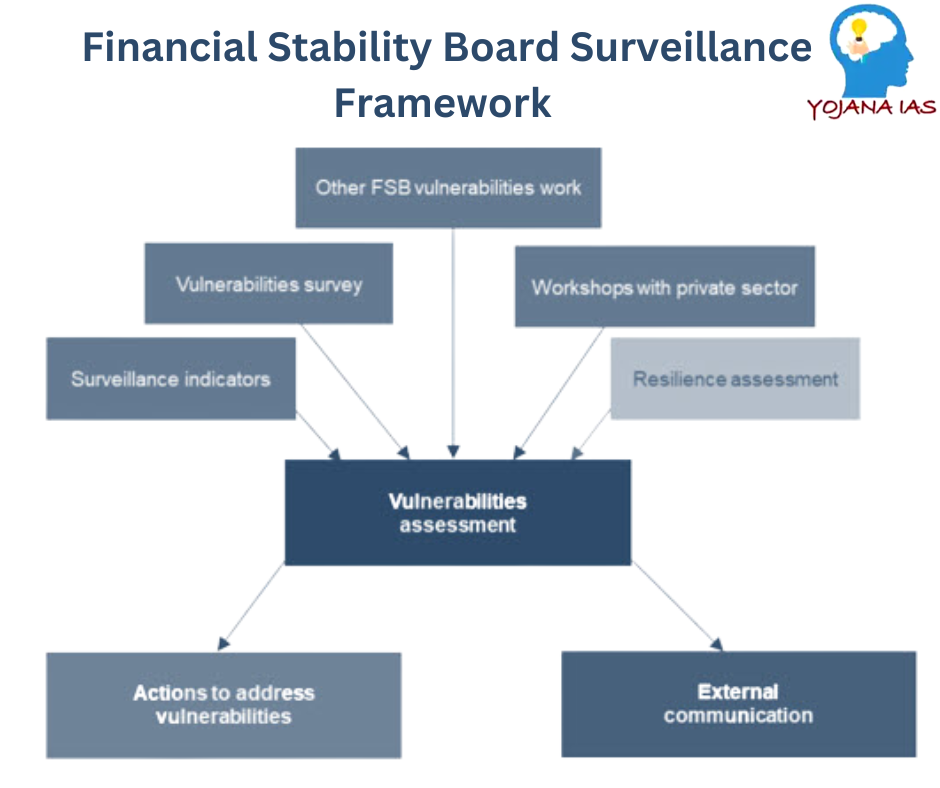28 Feb 2023 Financial Stability Board
Financial Stability Board
This article covers “Daily current events “and the topic is about the ‘Financial Stability Board’ which is in news, it covers “Economy” In GS-3, and the following content has relevance for UPSC.
For Prelims: Financial Stability Board
For Mains: GS-3, Economy
Why in news: The International Monetary Fund (IMF) and the Financial Stability Board have created a new synthesis paper that will serve as the foundation for the upcoming global crypto guidelines (FSB).
About Financial Stability Board
- The Financial Stability Board (FSB) is an international organization that keeps tabs on the world financial system and offers suggestions.
- The FSB works to stabilize the global financial system.
- It accomplishes this by integrating the efforts of international standard-setting organizations and national financial authorities in order to create effective regulatory, supervisory, and other financial sector policies.
- Promoting the consistent application of these policies across industries and jurisdictions, it promotes a level playing field.
Aims of the Financial Stability Board
- Examining the global financial system’s vulnerabilities as well as the accompanying regulatory, supervisory, and other activities that are required to address them and their consequences. All of this is done from a macroprudential viewpoint.
- Encourage cooperation and communication between the organizations responsible for maintaining financial stability.
- Monitor market changes and provide advice on how they may affect regulatory policy.
- Monitor regulatory standards compliance and provide advice on best practices.
- Do collaborative strategic evaluations of the organizations that establish international standards and coordinate each organization’s work on policy formulation to make sure that it is timely, well-organized, prioritized, and tackles any gaps.
- To build and maintain supervisory colleges, and establish rules.
- In particular with relation to systemically significant enterprises, support contingency planning for international crisis management.
- Conduct Early Warning Exercises in cooperation with the International Monetary Fund (IMF).
- The FSB’s principal tool for identifying and evaluating risks in the financial system is the Standing Committee on Assessment of Vulnerabilities (SCAV).
- The task of conducting additional supervisory analysis or formulating a regulatory or supervisory policy response to a substantial vulnerability identified by SCAV is assigned to the Standing Committee on Supervisory and Regulatory Cooperation (SRC).
- The FSB’s agreed-upon policy initiatives and international standards implementation are overseen by the Standing Committee on Standards Implementation (SCSI).
- The FSB’s budget and resources are under the control of the Standing Committee on Budget and Resources (SCBR).
- Regional Consultation Groups (RCGs) ensure that the Financial Stability Board’s (FSB) numerous initiatives and policies are carried out in regions outside of the G20. They encourage communication among FSB members and non-members.
Structure and Framework

Financial Stability Board
- The FSB’s principal tool for identifying and evaluating risks in the financial system is the Standing Committee on Assessment of Vulnerabilities (SCAV).
- The task of conducting additional supervisory analysis or formulating a regulatory or supervisory policy response to a substantial vulnerability identified by SCAV is assigned to the Standing Committee on Supervisory and Regulatory Cooperation (SRC).
- The FSB’s agreed-upon policy initiatives and international standards implementation are overseen by the Standing Committee on Standards Implementation (SCSI).
- The FSB’s budget and resources are under the control of the Standing Committee on Budget and Resources (SCBR).
- Regional Consultation Groups (RCGs) ensure that the Financial Stability Board’s (FSB) numerous initiatives and policies are carried out in regions outside of the G20. They encourage communication among FSB members and non-members.
Functions of the Financial Stability Board
- It is responsible for composing annual reports on the application of changes and their results.
- It coordinates a wide range of financial sector policy operations.
- It engages in outreach initiatives.
- Aids in creating more resilient financial organizations.
- It assists in the oversight of financial markets on a global scale.
- It contributes to the safety of the derivatives market.
- It makes non-bank financial intermediation more resilient.
- It develops a range of measures to support the world financial market.
- The G20 is in charge of creating progress reports.
- It carries out peer reviews and is in charge of evaluating the effects of reforms.
India and Financial Stability Board
- India is an active member of the FSB, and its three representatives—Secretary (EA), Deputy Governor-RBI, and Chairman-SEBI—occupy three seats in its Plenary.
- Periodic conference calls and meetings provide regular communication with the FSB.
- In accordance with global standards, information is frequently transferred to FSB member nations.
- To represent India’s interests before the FSB, the FSDC Secretariat in the Department of Economic Affairs works in concert with the various financial sector regulators and other pertinent organizations.
Conclusion
In order to reinforce the institutional foundation for financial stability in a globalized society, the Financial Stability Board was established as an international organization. After the financial crisis, a major need for such a body emerged. It aids in the spread of common guidelines for addressing financial stability in diverse nations.
Source:
Get Current Affairs from Yojna IAS


No Comments